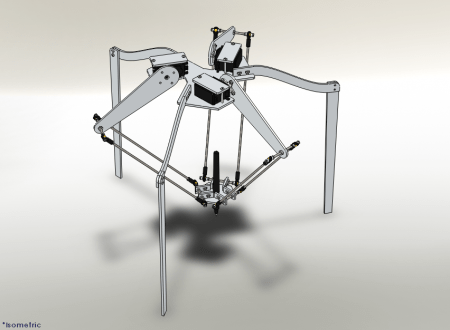[Pythagoras] is a delta robot built originally using RC servos. Humbly, [Aaron] “concedes” that the first version of his delta robot using hobby servos was easy to build. As anyone who has built any kind of robot knows though, there is definitely a lot of work involved in even the simplest robot. Coordinating three axes and programming it to draw a picture is a really great accomplishment.
The second version, however is currently in development and uses stepper motors instead of servos. These upgraded motors should make the robot faster, more controllable, and more accurate. This version is at least somewhat working as evidenced by the time-lapse video after the break.
Although the title page listed above is a little sparse on build details, if you dig deeper into the page, there are actually 15 articles about the ‘bot, so be sure to poke around.
[youtube http://www.youtube.com/watch?v=TxmmQhV0KS0%5D
If that’s not enough delta robot fun for you, be sure to check out this article about a delta robot controlled by a Kinect, or this attempt at a 3D printing delta ‘bot!

















This is very cool! I still hope to build one out of lego mindstorms someday. Anyway, what puzzles me is that this type of bot much better suited to vector drawing, so why make it do raster? That is still a great accomplishment and really demonstrates the accuracy.
Hi, I’m Aaron, the maker of Pythagoras. The robot has both vector and raster modes. Vector mode is great for line art, and raster mode, as seen in the video, is great for faces and other things where shadowing is important.
I wish you luck on your mindstorms robot!
Hi, I’m Aaron, who made the robot. It can do both vector and raster images. Vector is better for line drawing, raster works better for images where intensity and shadowing is important, such as faces.
Good luck on your robot! If you have any questions, feel free to contact me.
Looks like his first drawings (or.. it’s first drawings?) were vector. Seems like he wanted to experiment with doing grey scale images while only using one pen. Kind of neat still.
First of all awesome selection in pen, Pilot G-2 FTW.
Question to the other hackers because I don’t know any better, Wouldn’t a 2 axis pen that has a free floating(weight supported by rollers on paper) platform and a servo to apply down pressure to the pen be much easier to program?
This with some type of router bit on it could carve some 3d models from styrofoam or similar.
Sounds like you described this: http://www.instructables.com/id/Polargraph-Drawing-Machine/
Easier to program? Yes, but I wanted to make a robot full of delta-y goodness.
As the programmer of the polargraph machine mentioned above, I will agree that the reason I made a 2d one instead of a delta is because it was much simpler! (ie I could actually figure it out) I wish I had some delta-y goodness :(
Saw one of your earlier versions at the Mini-Maker Faire at Tech. Nice improvements. Go Dude!
I would like to see a mobile robot do something like this on and extremely large surface.
He did a very good job. Making a good delta robot is not a very easy task at all; the kinematics are very complex, far more complex than they are for a 6-axis arm or a SCARA robot.